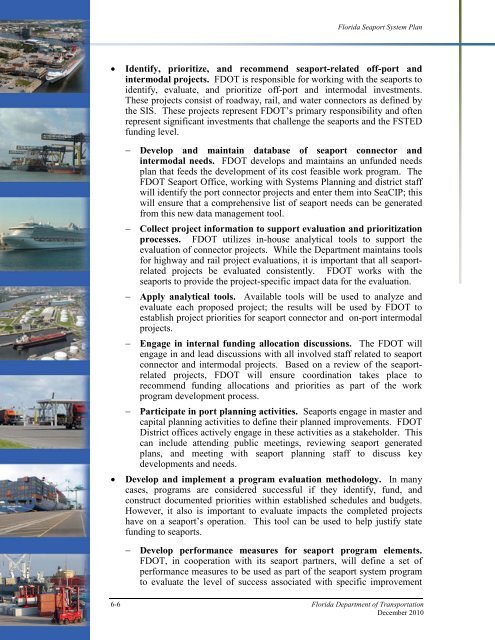Florida Seaport System Plan - SeaCIP
Florida Seaport System Plan - SeaCIP
Florida Seaport System Plan - SeaCIP
Create successful ePaper yourself
Turn your PDF publications into a flip-book with our unique Google optimized e-Paper software.
<strong>Florida</strong> <strong>Seaport</strong> <strong>System</strong> <strong>Plan</strong><br />
• Identify, prioritize, and recommend seaport-related off-port and<br />
intermodal projects. FDOT is responsible for working with the seaports to<br />
identify, evaluate, and prioritize off-port and intermodal investments.<br />
These projects consist of roadway, rail, and water connectors as defined by<br />
the SIS. These projects represent FDOT’s primary responsibility and often<br />
represent significant investments that challenge the seaports and the FSTED<br />
funding level.<br />
− Develop and maintain database of seaport connector and<br />
intermodal needs. FDOT develops and maintains an unfunded needs<br />
plan that feeds the development of its cost feasible work program. The<br />
FDOT <strong>Seaport</strong> Office, working with <strong>System</strong>s <strong>Plan</strong>ning and district staff<br />
will identify the port connector projects and enter them into <strong>SeaCIP</strong>; this<br />
will ensure that a comprehensive list of seaport needs can be generated<br />
from this new data management tool.<br />
− Collect project information to support evaluation and prioritization<br />
processes. FDOT utilizes in-house analytical tools to support the<br />
evaluation of connector projects. While the Department maintains tools<br />
for highway and rail project evaluations, it is important that all seaportrelated<br />
projects be evaluated consistently. FDOT works with the<br />
seaports to provide the project-specific impact data for the evaluation.<br />
− Apply analytical tools. Available tools will be used to analyze and<br />
evaluate each proposed project; the results will be used by FDOT to<br />
establish project priorities for seaport connector and on-port intermodal<br />
projects.<br />
− Engage in internal funding allocation discussions. The FDOT will<br />
engage in and lead discussions with all involved staff related to seaport<br />
connector and intermodal projects. Based on a review of the seaportrelated<br />
projects, FDOT will ensure coordination takes place to<br />
recommend funding allocations and priorities as part of the work<br />
program development process.<br />
− Participate in port planning activities. <strong>Seaport</strong>s engage in master and<br />
capital planning activities to define their planned improvements. FDOT<br />
District offices actively engage in these activities as a stakeholder. This<br />
can include attending public meetings, reviewing seaport generated<br />
plans, and meeting with seaport planning staff to discuss key<br />
developments and needs.<br />
• Develop and implement a program evaluation methodology. In many<br />
cases, programs are considered successful if they identify, fund, and<br />
construct documented priorities within established schedules and budgets.<br />
However, it also is important to evaluate impacts the completed projects<br />
have on a seaport’s operation. This tool can be used to help justify state<br />
funding to seaports.<br />
− Develop performance measures for seaport program elements.<br />
FDOT, in cooperation with its seaport partners, will define a set of<br />
performance measures to be used as part of the seaport system program<br />
to evaluate the level of success associated with specific improvement<br />
6-6 <strong>Florida</strong> Department of Transportation<br />
December 2010
















